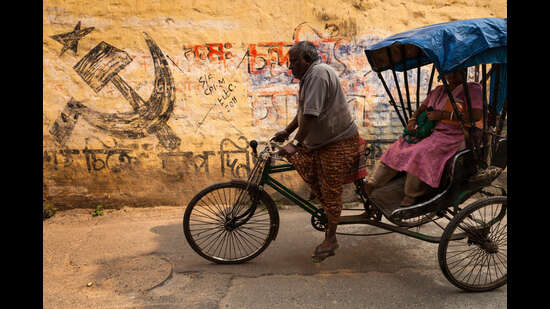Rich Kerala, poor Bengal, and the role of the party
West Bengal's economy has sharply declined since the 1980s, while Kerala has prospered due to demographic changes and a pro-business CPI(M) stance.
Four decades ago, West Bengal was among India’s most industrialised state economies. One in seven factory workers in India was from Bengal. Its per capita income was higher than the national average, and among the top 10 states. Among major states (population above 10 million), only four (Punjab, Maharashtra, Haryana, and Gujarat) had higher per capita incomes than Bengal.

Since then, Bengal’s economic fortunes have witnessed a stark reversal. Between 1981 and 2021, Bengal’s share in the national economy declined 3.3 percentage points to 5.8%. Its share in the industrial workforce fell nearly 10 percentage points over the same period to 4%. Its per capita income put it among the bottom 10 states in 2021.
Much of the blame for Bengal’s decline has fallen on the Communist Party of India (Marxist). The CPI(M) enjoyed an uninterrupted stint in power for more than three decades there. During its reign, trade unionism grew while capital flew. The CPI(M)’s efforts to woo industrialists during the fag end of its reign proved unsuccessful, and only served to hasten its electoral decline.
Surprisingly, the other key CPI(M) bastion hasn’t suffered the same fate. Over the past four decades, Kerala has moved up the league tables even as Bengal declined. In 1981, Kerala’s per capita income was below the national average. By 2021, its per capita income was 53% higher than the national average. Among major states, only five states (Haryana, Telangana, Karnataka, Tamil Nadu, Gujarat) had higher per capita incomes than Kerala in 2021.
Income growth in Kerala picked up in the post-1991 era. The penetration of cars and white goods rose sharply across the state. The share of households with private cars in Kerala (24%) was the highest among major states in 2019-21, according to National Family Health Survey data. The share of households with refrigerators (76%) was the second-highest among major states. 40% of households in Kerala belong to the top wealth quintile of the country; the same figure for Bengal is just 8%.
Kerala has managed to prosper even though its share in the national economy hasn’t increased much over the past four decades. It hasn’t experienced the kind of industrial boom that Tamil Nadu has witnessed or the IT boom that Karnataka has witnessed.
What explains Kerala’s prosperity then? One key driving force appears to be demographic change. Thanks to the early investments — by both Communist and non-Communist governments — in health and education, Kerala’s fertility decline began much earlier than the rest of the country. Kerala’s share in the national population has declined even as its income share has remained broadly unchanged over the past four decades. So, growth in income per person has outpaced most other states.
The second driving force is the state’s unique labour flow patterns. Like Bengal, Kerala also witnessed militant trade unionism. While Bengal’s youth found poorly-paid jobs in the rest of the country, Kerala’s youth found more lucrative jobs in the Gulf region. Kerala’s historic trade links with West Asia made it a natural destination for Kerala’s youth, the economists Tirthankar Roy and K Ravi Raman wrote in a recent article for Aeon. Inward remittances became a lifeline for the state, sustaining high consumption levels, and helping provide seed capital for small-scale family businesses.
If emigrants from Kerala provided the initial funds for new businesses, inward migration from other states provided the “labour power” to sustain them. Partly because of their small size, and partly because they relied on outsiders who weren’t part of the state’s trade unions, family-owned enterprises faced very little trouble from local party bosses.
The third driving force is the deepening friendship between the Kerala unit of the CPI(M) and the party’s “class enemy”. The CPI(M) in Kerala has gradually tempered its opposition to private capital over the past three decades. The recent move to allow divestment of public sector enterprises (which the party still opposes nationally) is a continuation of that trend.
Kerala’s new generation of entrepreneurs comes from the same social groups that form the CPI(M)’s support base. As partymen and their relatives tasted success in their business ventures, the CPI(M)’s engagement with businesses grew.
In contrast, the dominant social groups in Bengal haven’t tasted success in business for a very long time. This could be a major reason behind the state’s “anti-business culture”, the economist Pranab Bardhan has argued.
Marwaris and Gujaratis who ran successful businesses in the state were resented for their success, and viewed as outsiders. Since Bengali society developed a distaste for business, the ruling regime was never compelled to rethink its attitude toward private capital. Perhaps that also explains why Bengal remains an unfriendly place for business long after the CPI(M) was voted out of power.
Pramit Bhattacharya is a Chennai-based journalist. The views expressed are personal
All Access.
One Subscription.
Get 360° coverage—from daily headlines
to 100 year archives.



HT App & Website






